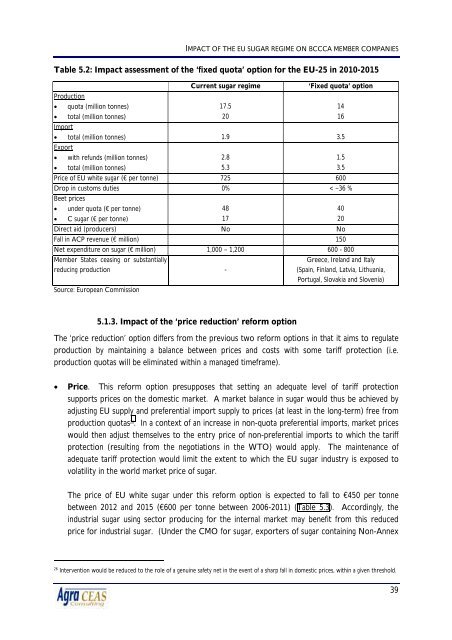2205 final report.pdf - Agra CEAS Consulting
2205 final report.pdf - Agra CEAS Consulting
2205 final report.pdf - Agra CEAS Consulting
Create successful ePaper yourself
Turn your PDF publications into a flip-book with our unique Google optimized e-Paper software.
IMPACT OF THE EU SUGAR REGIME ON BCCCA MEMBER COMPANIES<br />
Table 5.2: Impact assessment of the ‘fixed quota’ option for the EU-25 in 2010-2015<br />
Production<br />
Current sugar regime<br />
‘Fixed quota’ option<br />
• quota (million tonnes) 17.5 14<br />
• total (million tonnes) 20 16<br />
Import<br />
• total (million tonnes) 1.9 3.5<br />
Export<br />
• with refunds (million tonnes) 2.8 1.5<br />
• total (million tonnes) 5.3 3.5<br />
Price of EU white sugar (€ per tonne) 725 600<br />
Drop in customs duties 0% < –36 %<br />
Beet prices<br />
• under quota (€ per tonne) 48 40<br />
• C sugar (€ per tonne) 17 20<br />
Direct aid (producers) No No<br />
Fall in ACP revenue (€ million) 150<br />
Net expenditure on sugar (€ million) 1,000 – 1,200 600 - 800<br />
Member States ceasing or substantially<br />
reducing production -<br />
Source: European Commission<br />
Greece, Ireland and Italy<br />
(Spain, Finland, Latvia, Lithuania,<br />
Portugal, Slovakia and Slovenia)<br />
5.1.3. Impact of the ‘price reduction’ reform option<br />
The ‘price reduction’ option differs from the previous two reform options in that it aims to regulate<br />
production by maintaining a balance between prices and costs with some tariff protection (i.e.<br />
production quotas will be eliminated within a managed timeframe).<br />
• Price. This reform option presupposes that setting an adequate level of tariff protection<br />
supports prices on the domestic market. A market balance in sugar would thus be achieved by<br />
adjusting EU supply and preferential import supply to prices (at least in the long-term) free from<br />
production quotas 26 . In a context of an increase in non-quota preferential imports, market prices<br />
would then adjust themselves to the entry price of non-preferential imports to which the tariff<br />
protection (resulting from the negotiations in the WTO) would apply. The maintenance of<br />
adequate tariff protection would limit the extent to which the EU sugar industry is exposed to<br />
volatility in the world market price of sugar.<br />
The price of EU white sugar under this reform option is expected to fall to €450 per tonne<br />
between 2012 and 2015 (€600 per tonne between 2006-2011) (Table 5.3). Accordingly, the<br />
industrial sugar using sector producing for the internal market may benefit from this reduced<br />
price for industrial sugar. (Under the CMO for sugar, exporters of sugar containing Non-Annex<br />
26<br />
Intervention would be reduced to the role of a genuine safety net in the event of a sharp fall in domestic prices, within a given threshold.<br />
39













